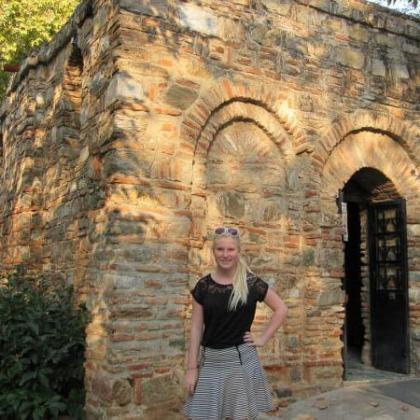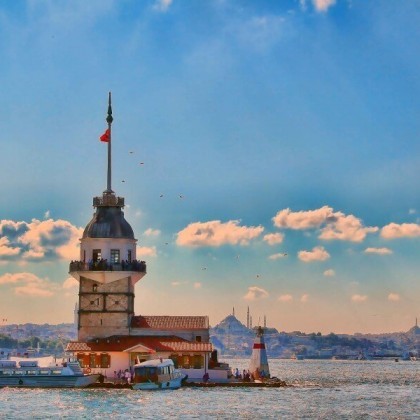Ephesus
Stretching from early archaic times to the 6th century AD, Ephesus’s glorious prosperity has not gone the way of other notable ancient cities’. To this day, Ephesus boasts a concentration of Classical art and architecture surpassed only by Rome and Athens. As both the capital of Roman Asia and the site of a large, wealthy port, Ephesus accumulated almost unparalleled wealth and splendor, the marble specter of which still leaves visitors in awe. The ruins rank first among Turkey’s ancient sites in terms of sheer size and state of preservation. No piles of weed-ravaged rubble await imaginative reconstruction work here. Instead, extensive marble roadways and columned avenues create an authentic impression of this ancient, metropolitan gateway to the Eastern world. The best time to visit is right when it opens, before the scorching midday summer sun and throngs of tourists obliterate the last remnants of lingering nighttime cool and silence.
Istanbul New Year’s Eve Party Cruise on the Bosphorus
IstanbulWith this new year's eve party program in Istanbul, you will have an amazing new year party on the Bosphorus. Book it now and don't miss the special price!
View Tour3 Days Ephesus, Pergamon and Pamukkale Tour Package
Ephesus, Pamukkale, PergamonIf you want to make an amazing trip to the Ephesus, Pergamon, and Pamukkale, you should read our tour itinerary.
View TourIstanbul and Cappadocia Tour – 7 Days
Istanbul, Cappadocia, TurkeyIf you want to make a trip to Istanbul and Cappadocia both, we strongly suggest you join this amazing package tour. This tour covers all the accommodations, transportations, lunches...
View TourBest of Turkey Package Tour – 8 Days
Istanbul, Cappadocia, Ephesus, PamukkaleAre you looking for a good traveling package in Turkey? With our 8-days Turkey tour, you will make a trip to every important sight in Turkey. Enquire now for...
View TourHISTORY
Fiery and intense, Ephesus’s history has all the makings of an ancient tragedy. Out of devotion to its patron goddess Artemis, residents maintained the city’s location near her colossal temple (now in modern Selçuk), even as they watched their harbor steadily fill with silt from the Cayster River. The recession of the sea had sealed the city’s fate by the 6th century, as the harbor deteriorated into a marshy wasteland and eventually became infested with malaria-carrying mosquitoes. A massive epidemic resulted in nearly 200,000 deaths.
Ephesus’s origins are equally romantic. The Delphic Oracle prophesied that a fish and a wild boar would determine the site for the founding of the city. After this proclamation, Androclus passed through a seaside village where fish were being roasted along the shore. One fish, covered in burning wood, fell from the fire, igniting a nearby bush and upsetting a wild boar, who tore out from the foliage. Androclus slew the boar, and heeding the oracle, he founded the city on the site.
The ancient traveler Pausanias deemed Ephesus the “most wondrous of the Seven Ancient Wonders and the most beautiful work ever created by mankind.” The first, major structure built entirely of marble and the largest edifice in the ancient Greek world, the Temple of Artemis was four times as big as the Parthenon. The 6th-century philosopher Heraclitus was so enamored of this massive monument that he deposited his enigmatic treatise on the nature of the universe in the temple instead of publishing it. He later claimed that no one but the gods could understand his theories anyway.
Remarkably, the Temple of Artemis was actually built twice. It was set afire during the reign of Mad King Hesostratos in 356 BC on the night of Alexander the Great’s birth. According to legend, the pyro-king succeeded only because Artemis watching over Alexander’s birth at the time was absent. Fittingly, Alexander himself offered to restore the temple when he passed through the city. The Ephesians, however, declined his offer and rebuilt the temple even more splendidly with their own resources and the offerings made by hundreds of thousands of pilgrims. Today, little remains of the magnificent structure. Goths sacked the sanctuary in the 3rd century, and the Byzantines followed suit. Some of the temple’s columns can be seen at Istanbul’s Aya Sofia and London’s British Museum.
Ephesus reached its zenith after 129 BC, when the Romans established the province of Asia with Ephesus as the capital. After Rome, it was second only to Alexandria in population, with more than 250,000 inhabitants. The ruins date primarily from this period. St. Paul, recognizing the significance of the metropolis, arrived in 50 AD and converted a small group of Ephesians to Christianity. Many perceived the development of the new religion as a threat to Artemis and Cybele (mother goddess of Anatolia) and forced St. Paul and his followers to depart. Eventually, Ephesus became a center of Christianity in the Roman Empire, so much so that the Ecumenical Council met here in 431. Pope Paul VI visited the site in 1967 and prayed with a congregation in the ruins of Ephesus’s 4th-century church.
TRANSPORTATION AND PRACTICAL INFORMATION
Contrary to the signs and advice given by the tourist offices in Kusadasi, Selcuk, and Samos, the guided tours of Ephesus are not recommended. Ephesus is easily reached by regular dolmuş or by walking from Selçuk, the ruins are in good repair, and there is an abundance of explanatory material. Why spend $30 on what is often a rushed and cursoiy look at the 2000-acre site? A good guidebook to Ephesus is about $2.50 in Kuşadası’s souvenir shops or at the entrance to the site.
Ephesus lies about 2-3km outside of Selçuk along the main Kuşadası-Selçuk road, Dr. Sabri Yayla Bul. The easiest way to get to Ephesus from Kuşadası or Selçuk is via the free shuttle service offered by practically every hotel and pansiyon. Otherwise, to get to Ephesus from the Kuşadası otogar, take a dolmuş to Selçuk and tell the driver to stop at Efes (30min., $.80). From the Selçuk otogar, take a Pamucakkale bound dolmuş toward Kuşadası (5min.; every 15min., Nov.- Apr. every 30min.; $.60). Taxis also min from Selçuk to Ephesus ($4) and to the House of the Virgin Mary (9km, $15 round-trip including 45min. to visit the house). Ephesus is an easy walk (25min.) from Selçuk along a shady path (beside Dr. Sabri yayla Bul.) that passes by the spectacular Ephesus Museum and the Temple of Artemis. The lower entrance, to which you arrive by dolmuş or on foot, has toilets ($.20) and a PIT that exchanges money until 4:30pm.
Aside from the stands selling chewy Turkish ice cream, the culinary offerings at the site are unimpressive, though there are some picnic tables just outside the site. Infinitely preferable is the gözleme tent just outside the entrance to the Seven Sleepers ($.80; ayran $.40). There are currently no accommodations in Ephesus.
EXPLORING EPHESUS
Open 8am-7pm. $5.60, students $2.50. Bring water and sunscreen.
VEDIUS GYMNASIUM AND STADIUM
On the left as you walk down the road that goes from Dr. Sabri Yayla Bul. to the lower entrance is the Vedius Gymnasium, built in 150 AD in honor of then-emperor Antonius Pius and Artemis, the city’s patron goddess. A marble path connects this structure to the Grand Theater at the head of the Arcadiane. Beyond the vegetation visible from the road lie the horse¬
shoe-shaped remains of the city’s stadium, constructed by the Greek architect Lysimachus and then expanded during the reign of Nero. The dual construction highlights the fundamental differences between Hellenic and Roman public enter¬tainment. The original Greek structure would have been a semicircular theater whose shape followed the contours of the land to add a natural emphasis to the staged dramas. The Roman stadium was built atop the old theater for the viewing of such martial spectacles as bloody gladiator games, wild beast hunts, and public executions. You can see the stone supports underneath the seats and the tunnels that served as an ancient world “green room” for wild beasts and gladiators.
ON THE WAY TO THE ARCADIANE
Of the three holy Christian sites in the Efes vicinity, only the very long, skinny building of the Church of the Seven Councils is in the Ephesus site itself. Just inside the lower entrance, a dirt path leads to the right; follow this path and turn right where it splits to the ruins of the Church. Here, the Ecumenical Council met in 431 AD to iron out the Nestorian Heresy, in which the bishop Nestor called into question the humanity of Christ. This was also the site of Pope Paul Vi’s visit in 1967. Beside the Church of the Seven Councils is the Archbishop’s Palace, which was destroyed by Arabs in the 6th century AD.
ALONG THE ARCADIANE
Back at the main entrance gate, a tree-lined path leads straight ahead to the Arcadiane, which could loosely be termed Ephesus’s main drag. Running from the Grand Theater to what was once the harbor, the magnificent, colonnaded marble avenue would have been thronged with stevedores (men who unload ships’ cargoes) and carts bringing wares from ships to sell in the agora. The street eventually liquefied into a small marsh, and only a few marble stumps remain of the covered arcade which ran along the sides of the main road. Ephesus was one of only three ancient cities that could afford street lighting. The large expanse of column stones laid out in tidy rows to the left as you face the theater are the remnants of the Theater Baths and Gymnasium. This area, used in the Roman period for training actors, is currently a focus of excavation.
Buried under nothing more than a dense swarm of tourists, the Grand Theater is a stunning, 30m by 145m, heavily restored beast. Its cavea (seating area), carved into the side of Mt. Pion, had a capacity of 25,000. (Archaeologists have used this number to estimate the population of this and other Hellenistic cities by multiplying the theater capacity by 10.) The hard marble and the sound catching colonnade across the top gave the theater excellent acoustics. The skene (where the scenery and props stand in a modem theater) is a forest of columns, stelae, and statues dating mostly from the reigns of Claudius and Trajan. Denizens of Ephesus placed 89 golden idols of Artemis here to celebrate the goddess’s annual festival each April. St. Paul railed against these same false gods. Today, the International Efes Festival is held here in September.
THE MARBLE ROAD
From the Grand Theater, you approach the Street of Curetes by walking along the Marble Way. To your right as you walk along the Marble Way is the agora, built during the reign of Nero. Currently off-limits, it, was once a large commercial area. A square stone in the center marks all that remains of the city’s horologium, a combination sundial and water clock that kept accurate time. At the southern end of the agora is the Gate of Maxeus and Mithridates, two wealthy freed men who had the gate built and dedicated to the first Roman emperor, Augustus. About halfway to the Street of Curetes, on the right-hand edge of the Marble Way, stands a small metal barrier surrounding and protecting a rough-hewn inscription thought to be the world’s first advertisement. The inscription consists of a picture of afoot, a cross, a woman, and a heart-shaped blob. The ad wizards of the day intended this to designate the brothel down the road. The foot indicated the view’er’s position as well as the need to walk to the crossroads ahead, represented by the cross. The heart above and to the left of the cross showed the house’s position at the intersection, and the woman depicted is just that, a woman. Sailors could follow these clear’ directions to the brothel, which was dedicated to the love goddess Aphrodite.
THE STREET OF CURETES
A slight incline signals the beginning of the Street of Curetes, which connected the city to the Temple of Artemis, now in Selçuk. Ruts in the road arc evidence of the enormous concentration of traffic between the temple and the city, and gaps between the slabs reveal glimpses of the city’s sewer system. At the very bottom of the Street of Curetes is the grand Library of Celsus, which was restored by Austrian archaeologists. A memorial to Gaius Julius Celsus and a general fount of knowledge, the library was covered with inscriptions recording important events and once contained 12,000 scrolls. The facade’s frontal curvature and the slight thinness of the peripheral columns serve to create an impression of greater width. This tempers the minimizing effect of being sandwiched between the broad agora and another building. Scholars suspect that the large building behind the library is the Temple of Sarapis, an Egyptian god associated with grain.
Walking up the Street of Curetes from the library, the brothel is on your left. Romantic commerce took place by oil light in the windowless side rooms, where archaeologists unearthed the infamous statue of Priapus, the god of fertility, now in Selçuk’s Efes Müzesi. Near the brothel is a well, still in use, whose waters were thought to make barren women fertile. Adjacent to the brothel are the Baths of Scholastica, built in the 5th century at the behest of a wealthy woman. You will find a public restroom just beyond the brothel.
Farther up the Street of Curetes you’ll see the imposing ruins of the Temple of Hadrian on your left. It is marked by its double-layered column construction, several friezes depicting the creation of Ephesus, and a bust of the goddess Cybele that adorns the keystone. The temple was built in 118 AD during Hadrian’s rule, atypical for Romans, who usually preferred to deify their emperors only after death. Modest, no? Covering the hillside on the right are the famous stephouses, which the local bourgeoisie called home. Since they are currently under excavation, most are off limits to tourists. A little further up the hill on the left are the ruins of the exquisite Fountain of Trajan. A statue of the Emperor Trajan, who extended the Roman Empire’s borders as far as the Indian Ocean, once stood before the fountain. Today only its base remains.
Two pillars in the middle of the road mark the Gate of Hercules. Farther uphill and to the left is the Prytaneion. Dedicated to the worship of Vesta (Hostia to the Greeks), goddess of the hearth and home, the Prytaneion contained an eternal flame that was tended by the Vestal Virgins, a small group of priestesses who served Vesta. Worship of Vesta was of such great significance to Romans that the Vestal Virgins were afforded social standing close to that of men immediately adjacent and in fine repair is the odeon (bouleterion), a small, once- covered theater that seated approximately 1500 people. It was used as both a the alert and a meeting place. The state agora on the right was the heart of political activity from the first century BC- until the city’s final demise. On the left after the odeon lie the upper baths.
TERRACE HOUSES
Just opened to the public in summer 2001, the Terrace I louses, located across from the Temple of Hadrian, are the newest jewel in the Ephesus crown. Believed to date back to the 6th-century Ionian period, the terueos were home to the wealthiest Ephesians in the 2nd century AD. They under went several restorations in the four centuries that followed. Only two houses are opened to the public, but both have fine examples of mosaics, frescoes, and period architecture (columned courtyard). Houses had running hot and cold water, a sewage system, and were heated from beneath the floors. Most impressive among I lie finds are an enormous domed bath and remarkably intact frescoes portraying mythological and theatrical scenes. While the site often is bypassed by tourists, it’s wnrl.li the extra entrance fee just to marvel at how little humankind has really pro-gressed over the past two millennia in terms of domestic architecture and amenities. (Open daily 8am-6:30pm. $5.60, students $2.50).
OTHER SITES
The road that runs by the top entrance of Efes leads to the House of the Virgin Mary, where, according to a legend supported by some archaeological and literary evidence, she lived with the Apostle John and later by herself after leaving Jerusalem. Much closer to the Ephesus site are the Caves of the Seven Sleepers, easily reached by leaving Ephesus through the bottom gate, turning right at the “Seven Sleepers” sign, and walking 10-15min. Legend has it that seven youths fleeing religious persecution under Emperor Decius slept in the cave for what they thought was a night. Upon waking, they discovered that they had slept for 112 years, during which time Christianity had become the official religion of the Empire. Amazed by their story, Emperor Theodosias II built a church atop the caves and decreed that the sleepers’ remains be buried there. AH that remains of the church is a fence in front of the cave. The youths’ tombs are atop the hill by the fence. (Open 24hr. Free.)





